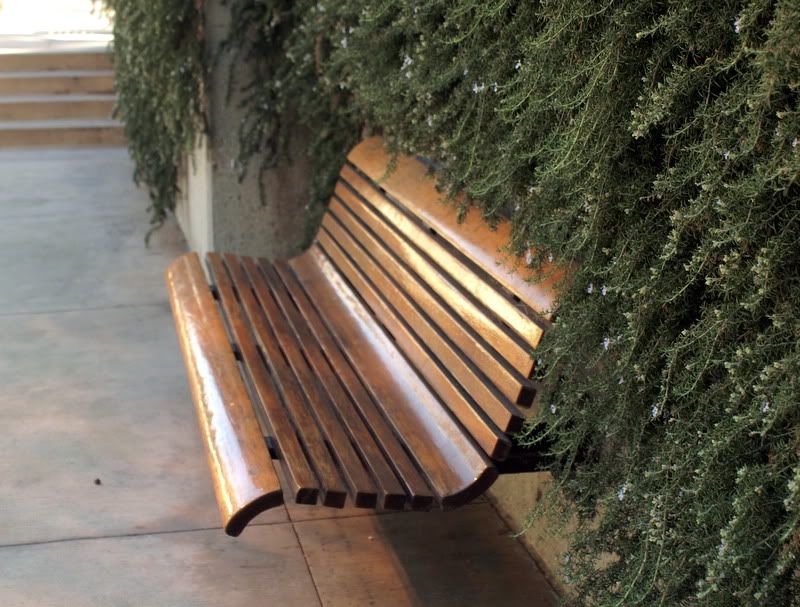I took this photo at an office plaza I worked near yesterday. I’m amazed that the rosemary was given this much leeway by the maintenance crew, which has no doubt been instructed to subjugate and six-pack the rest of the plantings into the usual rank uniformity seen here locally in public spaces. Maybe this dripping rosemary encroaching on sitting areas is a small act of defiance by the maintenance crew, who are possibly just as dispirited about the state of public plantings as I am. Rosemary is by no means a rarity in local public plantings, but allowing it to express its full botanical character in this way certainly is.

In a mediterranean climate where so many coveted plants can thrive, and do so with minimal water, I might add, the lack of excellent public planting displays is really getting on my last nerve. I’m talking about encountering plants outside the many excellent botanical gardens in Los Angeles, which are usually at least a 30-minute car ride away from just about any point you start from. The winter-blooming aloes should be encountered on the way to the grocery store and not just sequestered at the Huntington Cactus Garden, and the aloes should be seen in concert with other plants to display their best features, in season and out of season. You know, garden design. And I’m starting a process to do something about it, tapping into the amazing local design talent (Dustin, can we talk?) and excellent regional plant nurseries. Stay tuned. And if anyone has any stories to tell of their public/private partnerships in furtherance of amping up the volume of local horticulture, I’m all ears.
And be sure to check out MB Maher’s updated website. There’s some familiar images from his work posted here on AGO but lots of new stuff too.

There has been quite an effort in our town to do this, and with water-wise plants. Interesting to see what happens over time: everything starts out beautifully, but one by one the more sensitive or short-lived plants (kangaroo paws, lavenders, hybrid salvias, heucheras) die off, leaving a design with holes in it that are filled by survivor plants, which are then, of course, trimmed into cubes and meatballs by guys who trim everything into cubes and meatballs. And the weed-preventing, soil-enriching, moisture-retaining mulch is raked up with the trimmings and never replaced. And the survivor plants tend to be Raphiolepis indica, Ligustrum japonica, Agapanthus–the exact same plants found in conventional commercial plantings across So Cal.
I guess what I am saying is that without a long-term mindset for maintenance that includes plant replacement, and skilled plant-based care, (rather than gasoline-powered-machine-based care), in the long run, based only on what I have seen–you end up with same results as if you had planted the Raphiolepis, Agapanthus, and bermuda grass lawn in the first place. Sigh.
Don’t we all yearn for a garden stuffed with Stella d’ Oro, Agapanthus, Berberis cubes, Lavenders that are never replaced when they get woody, and maybe some Viburnum tinus infested with thrips ? I’m right on board with HoovB . However, I must say that winery parking lots here are a different matter altogether;aesthetics and ambiance are part of the tourista experience.We benefit.
Kudos to you Denise, if you can raise the bar–I will follow your efforts with interest..and hey , I saw my potting bench in the MB zone- a photo I never would have thought of taking. Those cuttings were planted in a bowl and delivered to DD last weekend.And Cornelius too !
Hoov, I agree that maintenance is going to be key, and I’m looking into tying it in with a local city college hort. program. We’ll see how far this idea goes. Feel free to chip in with whatever else occurs to your. Valuable information!
Kathy, must be odd to see your potting bench on someone else’s website. He might have alerted you! Amazing how the wineries have really stepped up to make Napa as garden-rich as it is.
Keeping the bucket brigade of interest and involvement going over time may mean multiple groups handing those buckets off now and again. Perhaps the web is a pathway to “institutional memory” for a planted site. Hort. students and instructors come and go, lose interest, lose budget, etc. Instructors have their own agenda which may or may not accomodate a project over the long term.
A website holding regular photographs (and documents) of a “project” evolving over time–years, not months!–may help to sustain interest as well as upkeep. Something to show mistakes made and lessons learned, no matter how much the individual involvement changes over the years.
I like how the so cal guerilla garden site tracks sites, showing plant sucesses & failures over time, even photos of something as simple as trash clean up. If one “guerilla” moves out of the area or whatever, new “guerillas” have a history to look back at. Also getting cooperation and tolerance if not support from the people who live right there by the site is apparently invaluable.
Maybe see if there is any help from CA Master Gardeners? Local garden clubs?
Hoov, I really appreciate your input! I’ve been gathering information and will send out a letter soon, so will keep you posted as to their response.